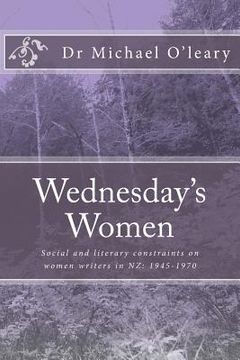Wednesday's Women: Social and literary constraints on women writers in NZ: 1945-1970
Reseña del libro "Wednesday's Women: Social and literary constraints on women writers in NZ: 1945-1970"
Wednesday's Women This study explores the reasons why so few women writers in Aotearoa New Zealand were seen as prominent figures in the literary scene from the end of World War Two up to the time when the feminist movement gained momentum, in the late 1960s and early 1970s. Using feminist methodology, I examine whether women writers were deliberately under-represented and their work trivialised by the male writers, critics and publishers of the time. What were the factors accounting for this under-representation? I also discuss to what extent there were successes and achievements, either literary or commercial, for the women writers of the time despite their real and/or perceived exclusion from the canon. Literary writers by definition create public documents, including manuscripts, working papers, and letters. The existence of such records means that perhaps more so than for many groups, we have evidence regarding attitudes, intentions, motives and responses to situations of the individual women writers of this period with which to answer these questions. The Georgians vs Modernists debate is examined. The starting date of 1945 for this thesis is significant for it was in that year that Allen Curnow's anthology A Book of New Zealand Verse was published. One of the striking things about the collection is that only two of the sixteen poets represented are women: Ursula Bethell and Robin Hyde. He did invite and encourage Eileen Duggan to contribute but she declined. Curnow's book went into a second edition in 1951 with twenty three poets, three of whom were women, Ruth Dallas being the third. In 1953 a book titled POEMS: Anthology of New Zealand Women Writers was published. This could be seen as an attempt to make up for Curnow's omissions. As evidence, I look to women writers of the time to see what restrictions on writing and publishing existed. In 1957 the literary magazine numbers published a letter by Willow Macky in which she criticises the critics of the New Zealand literary scene for their unfavourable reviews of the latest book by the poet Ruth Gilbert, The Sunlit Hour. Macky's letter was both a plea to her male colleagues and an indictment against them for their treatment of their female counterparts. She states: 'Most women, if they wish for success, will try to conform, monkey-like, to the masculine pattern; others, by remaining true to their feminine insight, risk opposition and failure in male-dominated fields' (Macky, 1957: 26). Was this the case and if so why? The 1970 cut-off date for this thesis coincides approximately with the development of the feminist movement in New Zealand. However, according to lesbian-feminist poet Heather McPherson, prejudice continued. McPherson had poems published in Landfall and had approached Leo Bensemann, then Caxton Press and Landfall editor, with a collection of poems. She mentioned to him that she had become a feminist. His reply was that Rita Cook (Rita Angus) had become a feminist 'but it didn't do her any good either' (McPherson, 2007: 116). These two examples illustrate some of the difficulties and antipathies that existed between the male and female literary figures, like Curnow and Macky, of the period which inform this thesis.To answer the questions posed above, I explore the social and historical context for women in this period, including the impact of the Second World War, and cover the careers of women poets and novelists, including some detailed case studies. I also examine the particular issues facing Maori and lesbian writers. I conclude that a supportive and encouraging environment was rarely available for women writers from 1945 to 1970, that most struggled to be published and appreciated, and that only later, if at all, were many of these important writers properly recognised.

